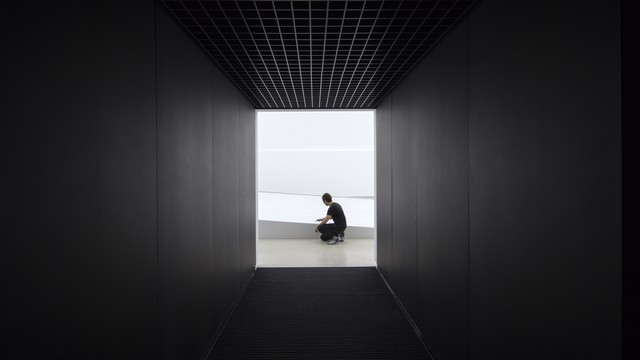Hyundai Pavilion Interactive Water Installation 2018, South Korea, Pyeongchang
An interactive choreography of water droplets




Hyundai Motor commissioned a pavilion for the Pyeongchang Winter Olympics 2018 in South Korea. Inside the 35m x 35m structure was a vast ‘water room’ – a multi-sensory water installation which emitted 25,000 singular water droplets every minute. Visitor interaction with a series of haptic sensors created new rhythms as droplets continually collided, joined, and split across the water landscape. Since the entire surface was finished with a hydrophobic coating, the water droplets remained intact, running towards a basin at the lower end of the installation. There, the flows of individual droplets collected, grew and built into a ‘lake’ which drained and reappeared in the space of minutes.
Hyundai Motor commissioned a pavilion for the Pyeongchang Winter Olympics 2018 in South Korea. Inside the 35m x 35m structure was a vast ‘water room’ – a multi-sensory hydrophobic water installation which emitted 25,000 singular water droplets every minute. Visitor interaction with a series of haptic sensors created new rhythms as droplets continually collided, joined, and split across the water landscape. A total of 258 nozzles were built into the circumference of the installation, and constantly emitted small amounts of water. Since the entire surface was finished with a hydrophobic coating, instead of merging into a continuous flow the water droplets remained intact. In addition, the water-resistant coating caused the water to run at an unnaturally fast speed over the surface. At the installation's lower end, the flows of individual droplets collected, grew and built into a ‘lake’ which drained and reappeared in the space of minutes. Visitors had the opportunity to take water from a narrow channel and pour it into a small funnel on the fringe of the installation. As soon as they did this, a large part of the water flow stopped, only the valve directly under the funnel remained open. A second possible interaction was offered on the long side of the installation. There, sensors were built into the edge that reacted to the physical proximity of visitors. As they moved their hands over a small aperture that emitted a gentle draft of air, the rhythm of the water droplets emerging from the valve beneath it doubled in speed. Thus, the uniformity of the moving droplets on the entire grooved surface was counteracted and transformed into a complex, continually changing rhythm. The water droplets of the interactive installation were inspired by individual Hydrogen molecules and the technology behind Hyundai’s new Hydrogen Fuel Cell vehicle.
Details
Building or project owner : Hyundai Motor Company
Architecture : Asif Khan
Project artist/ concept/ design/ planning : Asif Khan, iart
Structural engineering : Cutting Edge
Kinetic engineering : iart, Institute of Thermal and Fluid Engineering FHNW
Display content/ visuals/ showreel : Asif Khan, iart
Lighting control software : iart
Project co-ordination : Innocean Worldwide
Interaction design/ programming : Asif Khan, iart
Descriptions
Facade type and geometry (structure) : The water installation extended over nearly the entire area of the 20m x 12m space. It consisted of a three-dimensionally curved Corian surface with hydrophobic coating. The upper part of the installation featured grooves (including intersections, splits and junctions). At the lower end was the lake.
Kind of light creation : Droplet creation: A total of 258 nozzles were built into the circumference of the installation. They could be switched on an off, size and frequency of the droplets could be manually adjusted. The droplets emitted underneath the airholes could be adjusted individually in size and frequency.
Urban situation : The pavilion was located at a central site in the Olympic Park in Pyeongchang and attracted a total of 60,000 visitors.
Description of showreel : Visitors were able to interact with the installation either by pouring water in small funnels or by moving their hands over apertures that emitted a gentle draft of air. This allowed them to influence the rhythm of the water droplets. At the installation's lower end, the flows of individual droplets collected, grew and built into a ‘lake’ which drained and reappeared in the space of minutes.
Participatory architecture & urban interaction
Mediacredits
Luke Hayes
Luke Hayes
Luke Hayes
Luke Hayes
iart